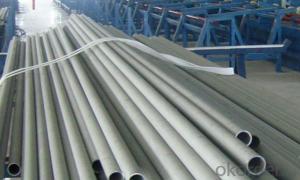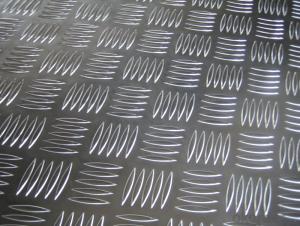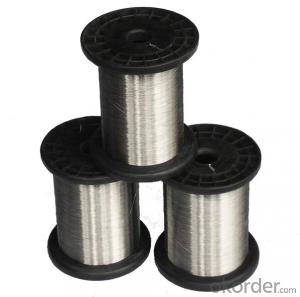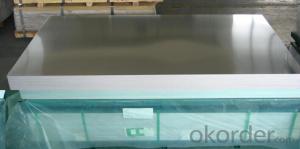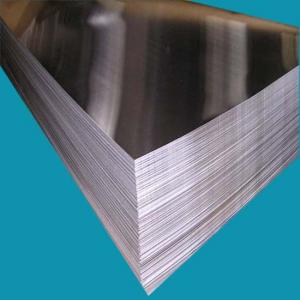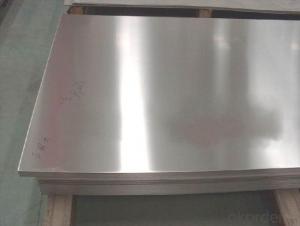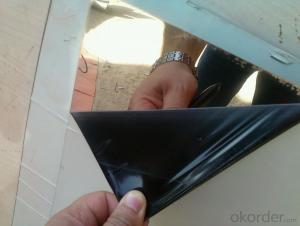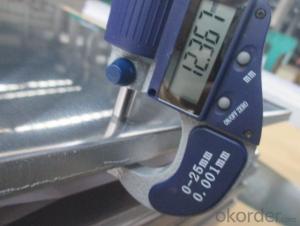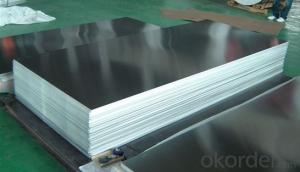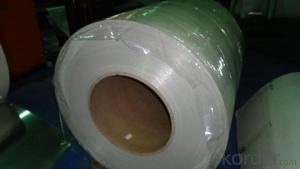Decorative Perforated Aluminum Cold Rolled Sheets with Best Price in Our Warehouse
- Loading Port:
- Shanghai
- Payment Terms:
- TT OR LC
- Min Order Qty:
- 5 m.t
- Supply Capability:
- 200 m.t/month
OKorder Service Pledge
OKorder Financial Service
You Might Also Like
Specification
1.Structure of Product Description
Cold rolled aluminum sheet and hot rolled aluminum slab are all widely used int he field of construction field and decoration field, etc.
There are many different grades, such as: 1000 series, 2000 series, 3000 series, 5000 series, 6000series, etc. The detailed grade are as follows: 1010, 1050,1060,5754,7075, 8011, etc.
The temper is include H14, H22, H24, H44,H112,H114,etc.
2. Main features of the product
a.Competitive price
c. Shortest service.
3. Image.

4. Product detailed sizes:
1000mm*2000mm, 1219mm*2438mm,1220mm*2440mm, 1250mm*2500mm,1500mm*3000mm, etc.
5. FAQ:
What is the quality standard?
---Usually our standard is GB3880-2006 or others.
What is the width range?
---It is from 1000mm to 2500mm, etc.
---Normally it is around 5 tons/each size.
How many tons did you export in one year?
---Normally it is around 9000 tons totally.
Where is your client from?
---Normally it is from Japan, USA, England, Canada, etc.
What is your mainly products?
---Normally they are aluminum sheet, big-5-bar checkered sheet, small-5-bar aluminum plate, mirror finish aluminium sheet, aluminum casting coil, etc.
- Q: Can 101 aluminum sheets be used in the production of consumer electronics?
- Yes, 101 aluminum sheets can be used in the production of consumer electronics. Aluminum is a versatile and lightweight material that is commonly used in the manufacturing of various electronic devices such as smartphones, laptops, tablets, and other consumer electronic products. It offers excellent thermal conductivity, corrosion resistance, and electrical conductivity properties, making it suitable for use in electronics. The specific grade of aluminum, such as 101, may have different characteristics that make it suitable for different applications. However, without more information about the specific requirements of the consumer electronics being produced, it is difficult to determine if 101 aluminum sheets are the most appropriate choice.
- Q: Can aluminum sheets be used for curtain walls?
- Yes, aluminum sheets can be used for curtain walls. Aluminum is a popular choice for curtain wall systems due to its lightweight nature, durability, and corrosion resistance. Aluminum sheets can be easily formed into various shapes and sizes, making them suitable for creating the structural frame of curtain walls. Additionally, aluminum can be coated or anodized to enhance its aesthetic appeal and provide additional protection against weather elements. This makes aluminum sheets a versatile and practical material for constructing curtain walls in commercial and residential buildings.
- Q: Explain how aluminum sheets impact the soundproofing capabilities of a building.
- <p>Aluminum sheets can have a significant impact on the sound insulation of a building. They are often used as a cladding material due to their durability and low maintenance requirements. However, aluminum is a good conductor of sound, which means it can transmit sound waves efficiently. This can reduce the sound insulation of a building, especially if the aluminum sheets are not combined with other soundproofing materials. To improve sound insulation, aluminum sheets can be combined with insulation materials, such as polyurethane foam, to create a barrier that reduces sound transmission. Additionally, using thicker aluminum sheets or adding a layer of sound-absorbing material can help enhance the soundproofing capabilities of a building.</p>
- Q: i heard that aluminum causes Alzheimers and i was wondering if there is any aluminum in tin.
- Tin is an element, so there isn't anything else in tin. However, tin, the element, isn't really used for much as *just* tin. Tin foil is really a mixture of tin and aluminimum, tin cans aren't pure tin. As elements go, tin is pretty rare. As for the Alzheimers, they don't really know what the correlation is; but they have found large accumulations of metals, not only aluminum, but it doesn't show that causes it. The expression ad hoc, ergo, procter hoc means, before, therefore it caused it. What I mean here is that just because they have found accumulations of aluminum in the brains of Alzheimer's, it doesn't mean it caused it any more than the fact that I did laundry this morning, caused me to spill my coffee on my husband. (both true). Just becasue they happened in that order doesn't mean A caused B. It could mean that whatever causes alzheimers could also mean that the brains of people suspectible to it have a greater ability to accumulate metals crossing the blood-brain barrier. We just don't know enough. I get porcelian caps on my teeth because they thought silver amalgam fillings was causing dementia. Hope I helped~
- Q: Can 101 aluminum sheets be purchased in small quantities or only in bulk?
- Aluminum sheets can typically be purchased in both small quantities and bulk, depending on the supplier and their policies. It is advisable to check with the specific supplier to determine the availability of purchasing 101 aluminum sheets in small quantities.
- Q: For example, in hydrangeas, when aluminum reacts with the anthocyanins in the flower's petals, the hydrangeas turn blue, but what chemical reaction occurs?
- Two factors affect the color in Hydrangea macrophylla cultivars: soil acidity and the presence of aluminium in the soil. To obtain a blue hydrangea, aluminum must be present in the soil. The pH of the soil should be low (4 - 4.5). In alkaline soil aluminium is tied up. The plants are unable to absorb the existing aluminium and the flowers will not bloom blue. Also, when aluminium in the soil is used up the flower color will be red or pink again. If the soil is watered with aluminium salts aluminium is accumulated in the petals and the color turns blue. Only red and pink colored Hortensis are suitable for the breeding of blue flowers. They contain the dye component delphinidin. At the end of this site you find explanation and the formula: www.uni-regensburg.de/Fakultaeten...
- Q: Are the aluminum sheets suitable for decorative purposes?
- Indeed, decorative purposes can be served by aluminum sheets. Aluminum, a material known for its versatility, can be effortlessly molded, trimmed, and maneuvered to produce a myriad of decorative components. Its lightweight nature, durability, and resistance to corrosion contribute to its widespread adoption for both indoor and outdoor uses. The availability of aluminum sheets in a vast array of finishes, colors, and patterns further amplifies the scope for limitless design options. Whether it is for embellishing architectural accents, crafting signage, manufacturing furniture, or producing artwork, aluminum sheets possess the potential to elevate the visual allure of any given area.
- Q: Can aluminum sheets be used for electrical enclosures?
- Yes, aluminum sheets can be used for electrical enclosures. Aluminum is a popular choice for electrical enclosures due to its excellent conductivity, corrosion resistance, and lightweight properties. It is a good conductor of electricity, allowing for efficient distribution of electrical current within the enclosure. Additionally, aluminum has a high resistance to corrosion, making it suitable for outdoor and harsh environment applications. Its lightweight nature also makes it easier to handle and install. Overall, aluminum sheets are a reliable and commonly used material for electrical enclosures.
- Q: So I want to solder aluminum cans together for this project I have. What tools will I need?
- a soldering iron or gun. use a low melting solder. it comes in various grades. go to Menard's or Home Depot they have it.
- Q: Can the aluminum sheets be custom-cut to specific dimensions?
- Yes, aluminum sheets can be custom-cut to specific dimensions. Aluminum is a versatile material that can be easily manipulated, allowing for precise cutting to meet specific requirements. Whether it is for industrial, commercial, or personal use, aluminum sheets can be tailored to the desired dimensions, ensuring a perfect fit for any project. This customization option allows for greater flexibility and ensures that the aluminum sheets can be used in a variety of applications.
Send your message to us
Decorative Perforated Aluminum Cold Rolled Sheets with Best Price in Our Warehouse
- Loading Port:
- Shanghai
- Payment Terms:
- TT OR LC
- Min Order Qty:
- 5 m.t
- Supply Capability:
- 200 m.t/month
OKorder Service Pledge
OKorder Financial Service
Similar products
Hot products
Hot Searches
Related keywords
